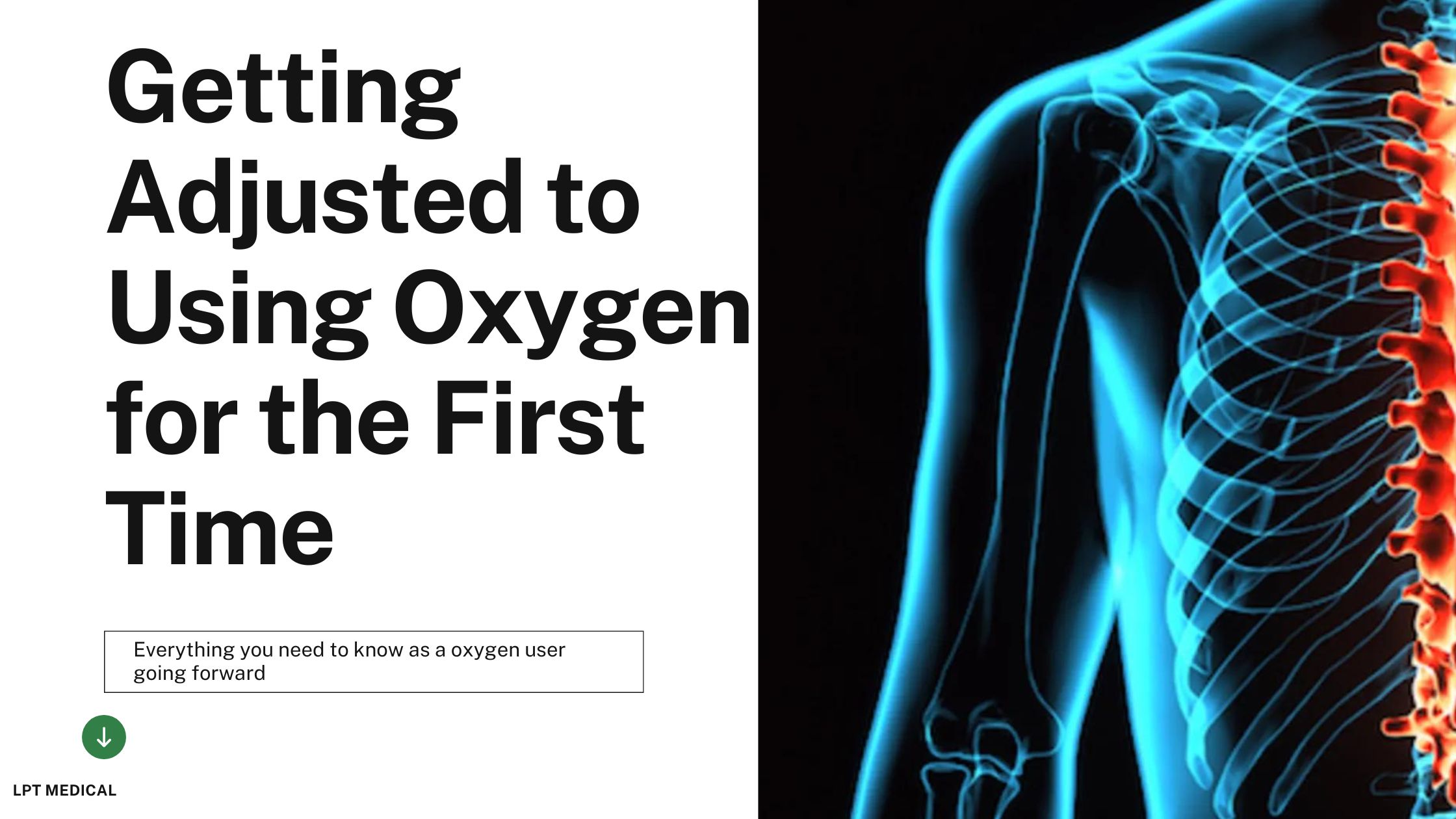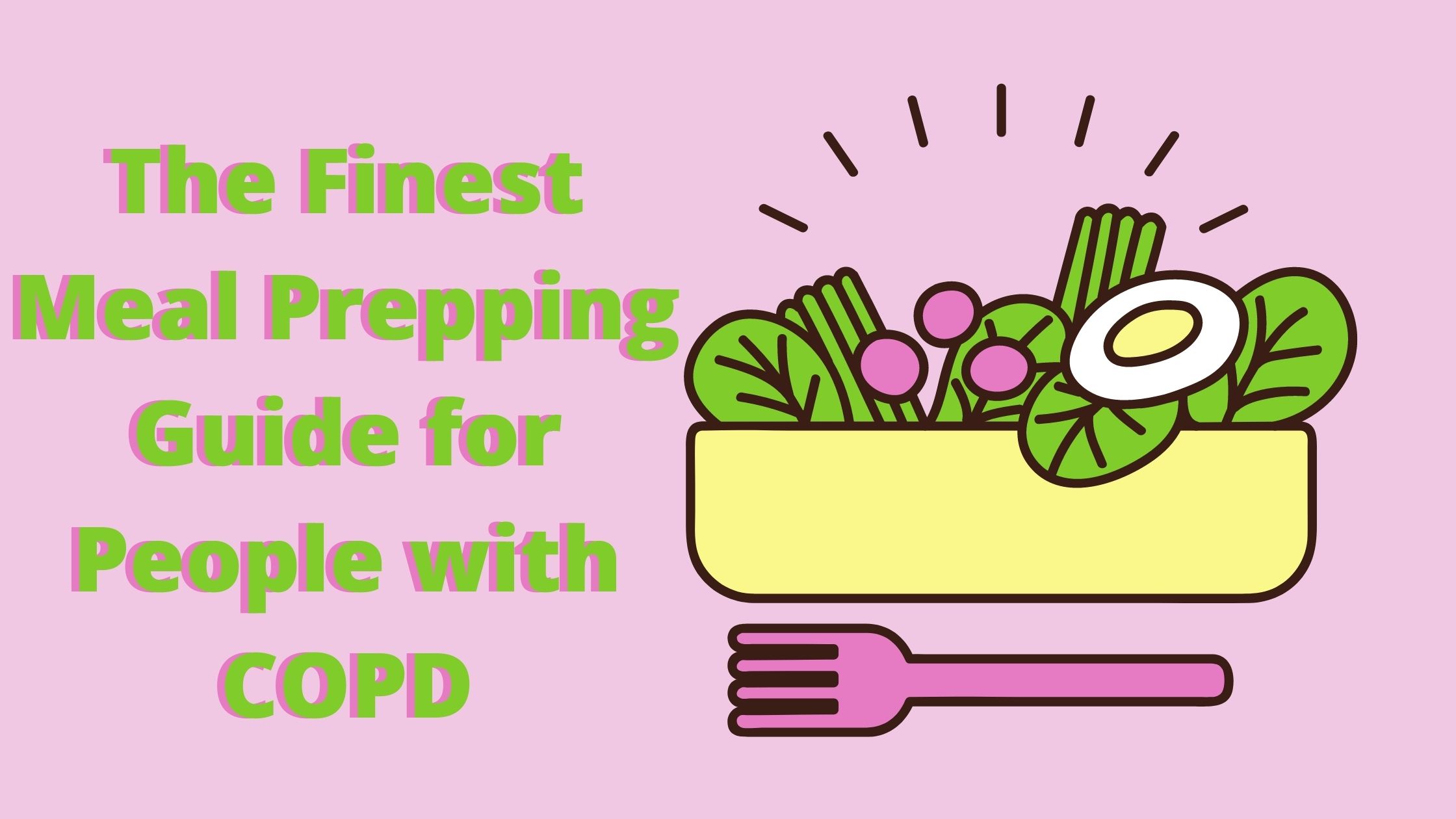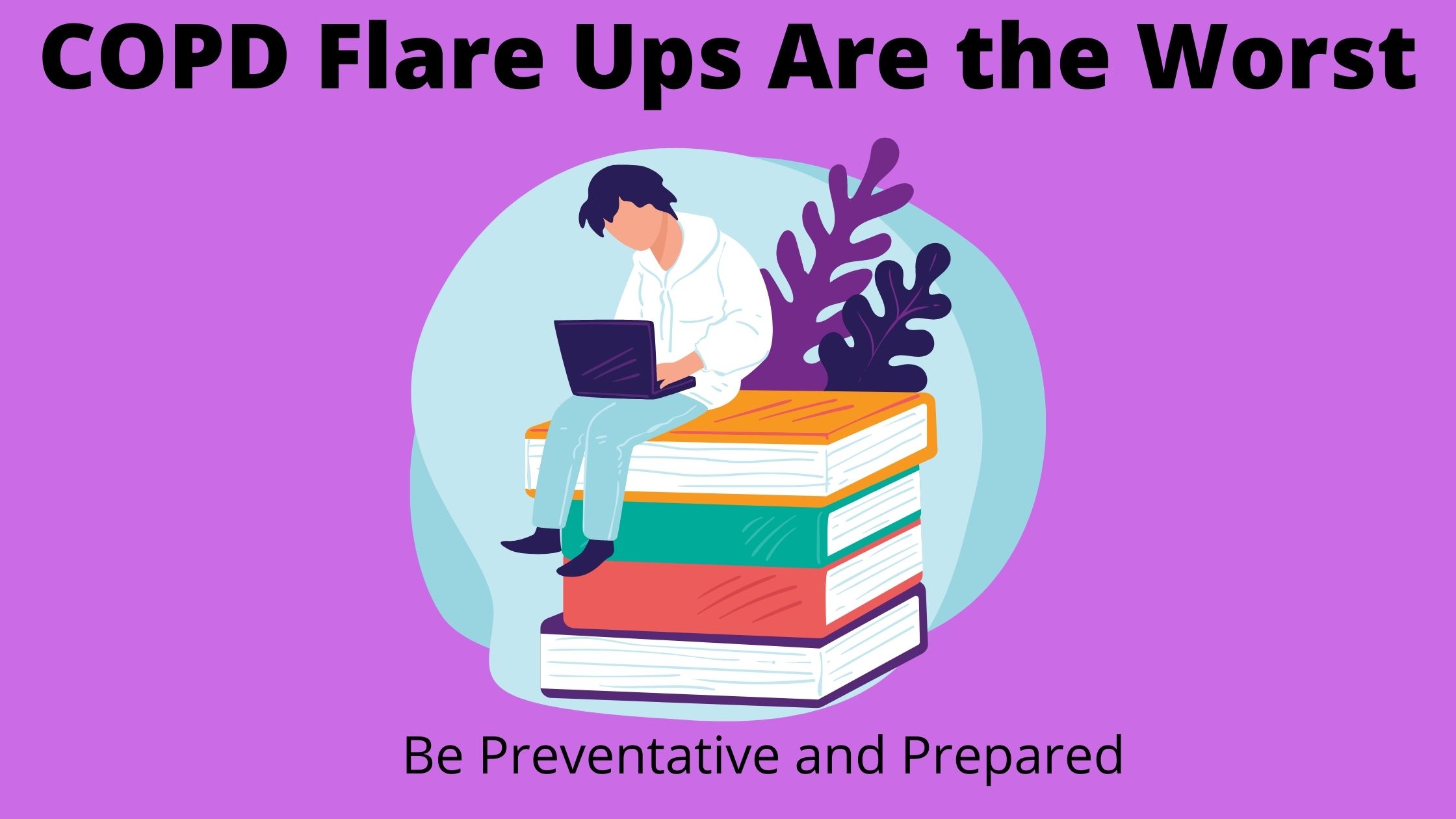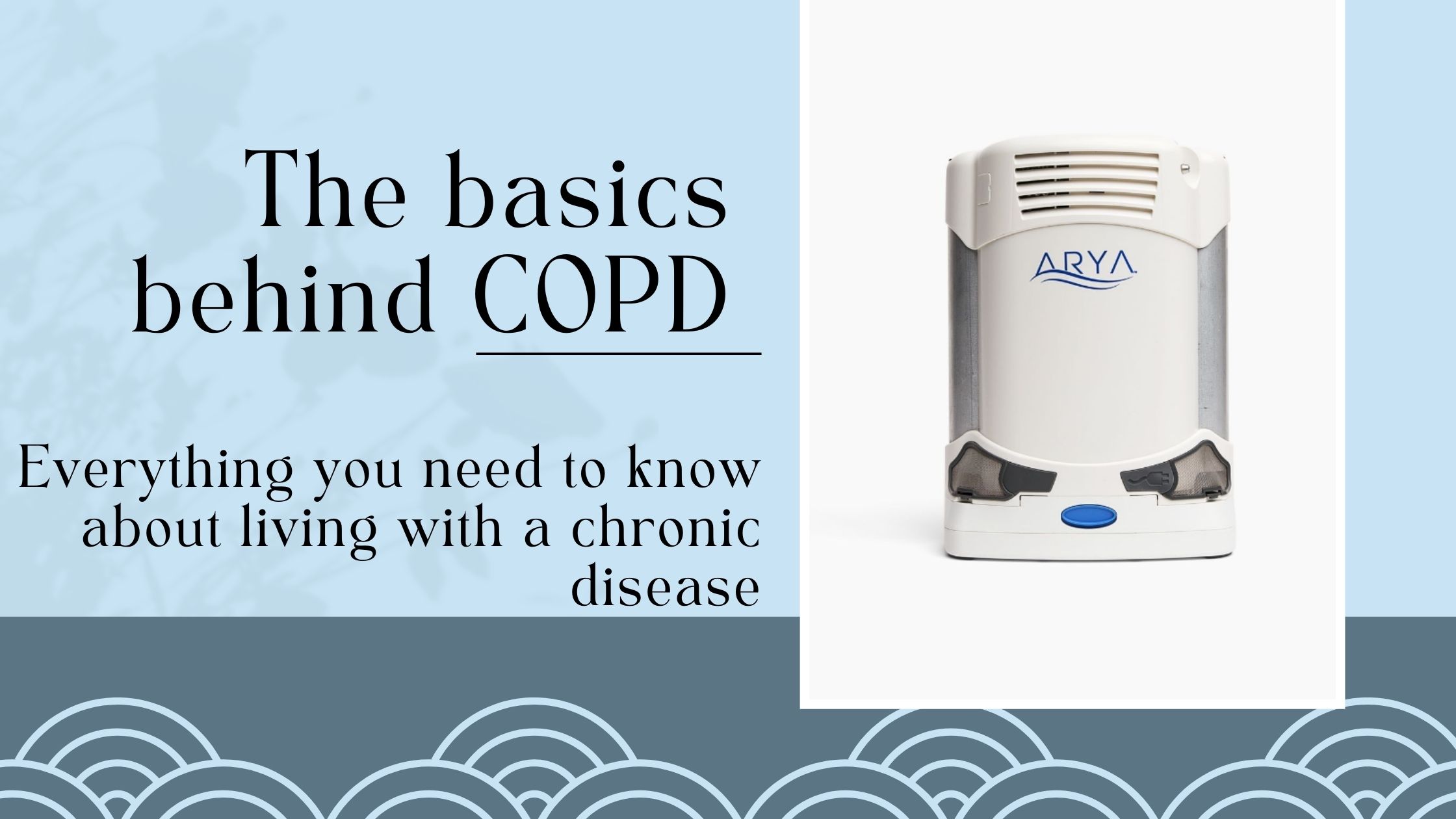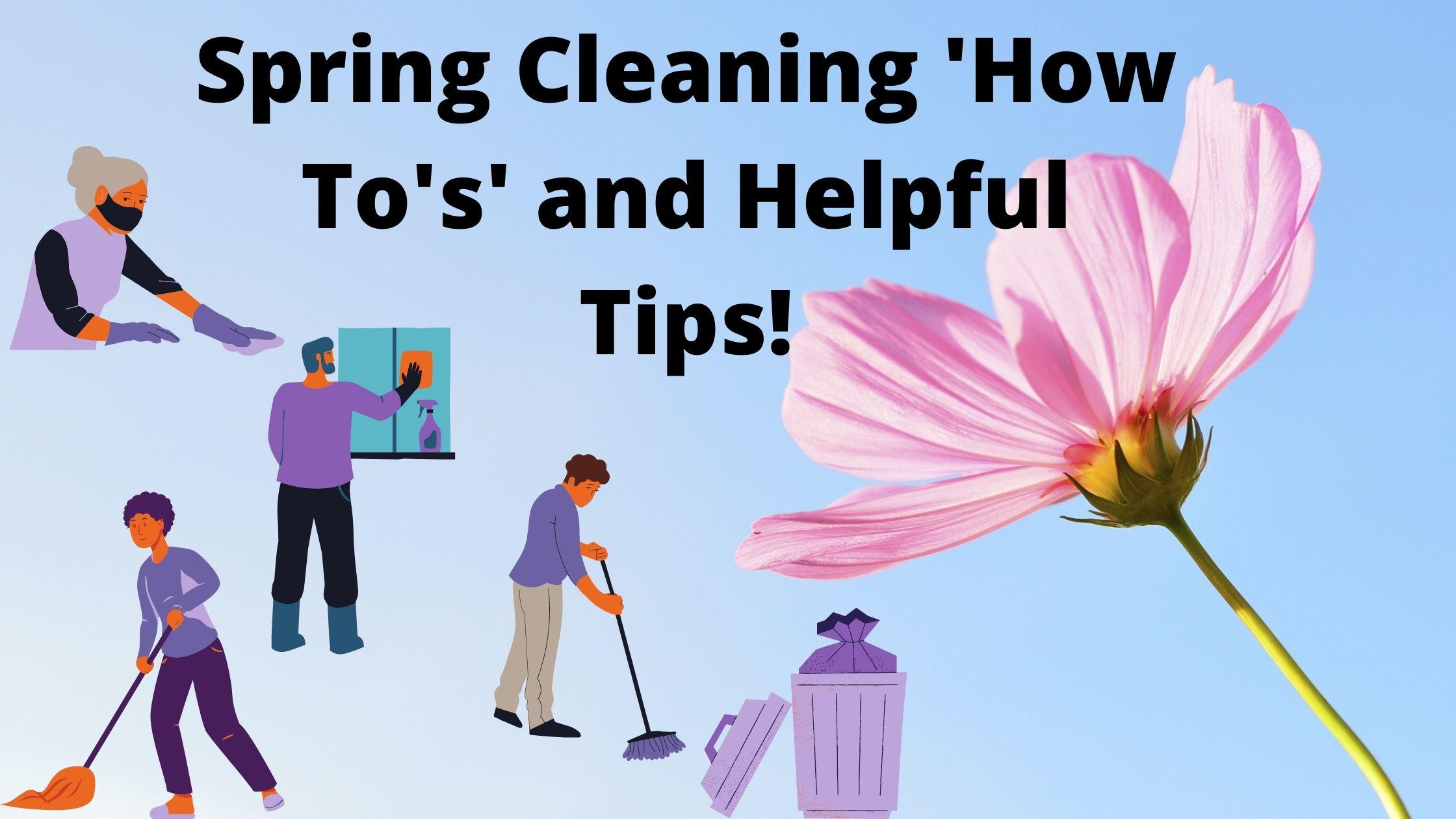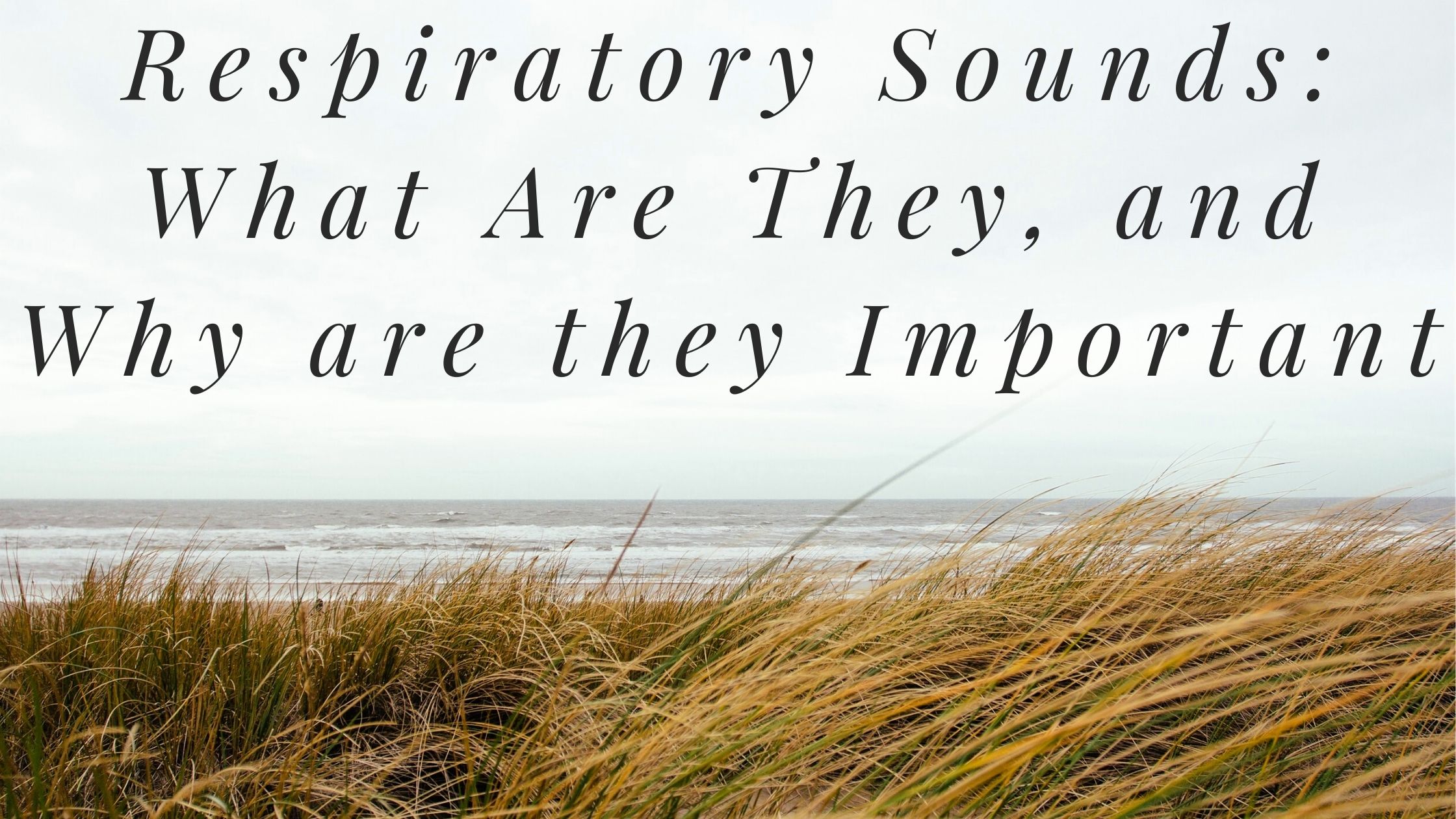
17 Natural Ways to Treat Your COPD
Aug 25, 2022 12:25:58 PM / by Ana Eyssimont posted in wellness goals, COPD education, COPD management, COPD Treatment
The Confusing Connection Between Drinking and COPD
Jul 27, 2022 2:55:15 PM / by Ana Eyssimont posted in COPD, COPD education, COPD management
Getting Adjusted to Using Oxygen for the First Time
Jul 20, 2022 2:14:52 PM / by Ana Eyssimont posted in Respiratory Resource Center, Tips and Hacks, oxygen therapy, wellness goals, COPD education, Travel, COPD Treatment
The Finest Meal Prepping Guide for People with COPD
Jul 7, 2022 11:26:33 AM / by Ana Eyssimont posted in COPD, Tips and Hacks, wellness goals, COPD education, COPD management
COPD Flare Ups Are the Worst: Be Preventative and Prepared
Jun 3, 2022 12:46:18 PM / by Ana Eyssimont posted in Medication and Treatment, wellness goals, COPD education
The Basics Behind COPD and the Secrets You Need to Know
Apr 19, 2022 11:00:12 AM / by Ana Eyssimont posted in Tips and Hacks, oxygen therapy, wellness goals, COPD education, COPD management
Spring Cleaning 'How To's' and Helpful Tips!
Apr 13, 2022 6:43:21 PM / by Ana Eyssimont posted in Tips and Hacks, wellness goals, COPD education
Spring is the season of new beginnings and fresh starts; it's the perfect time to get out your cleaning supplies and do some sprucing around the house. But spring cleaning isn't just a cliché, it makes sense to dedicate time once a year to catch up on chores and give some attention to neglected spaces in your home.
For people with COPD and other respiratory diseases, spring cleaning is an important opportunity to take care of lung irritants and hazards in the home. With spring allergens swelling and summer on the way, it's the perfect time to clear out clutter and make your home the cleanest, healthiest space it can be.
In this post, we're going to help you make the most out of spring cleaning by focusing on tasks that can help your COPD. We'll show you how to get rid of dust, mold, allergens, and how to improve your indoor air quality and ensure it continues to stay clean.
We'll give you tips for organizing your home to keep respiratory irritants at bay and ensuring outdoor allergens and pollutants don't build up in your home. We'll also show you how to protect your lungs from fumes, dust, and other particles while you clean, and how to make difficult cleaning projects easier to manage.
Keeping your home clean is not only good for a sound mind, but for healthy lungs as well. With the tips in this article, you can make sure you do spring cleaning right this year so you can enjoy the benefits of a healthy home the whole year round.
The Basics of Spring Cleaning
Regular cleaning year-round is important, but it's good idea to pause and pay attention to the details every so often. Even if you keep up with the necessities throughout the year, your house will inevitably collect hidden corners of dust and clutter and accumulate little maintenance and deep cleaning tasks that need attention.
If you let these things go for too long, they can become respiratory hazards and make your COPD symptoms worse. Dust, allergens, and toxic particles can sneakily build up in all sorts of places in your house, and spring cleaning is the perfect time to find and eradicate them all.
But before you get started, you should take some time to learn how to protect your lungs and go easy on your body while you clean. In the next sections, we'll discuss what kinds of supplies you'll need, what kinds of chemicals you should use, and how to protect your lungs from dust and fumes.
We'll also give you some general tips for cleaning as efficiently and effectively as possible, so you don't waste time and energy during your spring clean. COPD can make household tasks difficult, but planning ahead and learning new techniques can make cleaning easier and less tiring.
Protect Your Lungs When You Clean
The first thing you should consider is how you are going to protect your lungs from irritating particles and chemical fumes while you clean. After all, cleaning tends to kick up all sorts of respiratory irritants that can irritate your lungs and airways.
When you have COPD, cleaning without taking care to protect your lungs can do more harm than good, causing further lung damage and making your symptoms flare up. To clean safely, you need a two-pronged approach: using safe cleaning products and protecting your mouth and nose while you clean.
Avoiding Chemical Fumes
In general, you should avoid using commercial cleaning products, which are often made with harsh chemicals that can irritate your lungs airways. Instead, look for natural products made with mild ingredients or simply mix your own cleaning solutions at home.
Here are some chemicals that you should look out for and avoid using when you clean:
- Chlorine bleach
- Ammonia
- Detergents
- Aerosol sprays and fresheners
- Pesticides and fungicides
- Varnishes
- Floor wax and polish
- Oven cleaners
- Carpet cleaners
Commercial cleaning products aren't actually necessary for most cleaning tasks, and all you need is a few basic ingredients to make DIY cleaners for your home. Soap, vinegar, and baking soda are surprisingly effective for cleaning, and, when used in moderation, are much gentler on your lungs.
You should also stock some bleach and ammonia for more serious sanitizing, but be careful to never mix bleach and ammonia together. Be very careful to always examine the labels of any chemicals or cleaning products you have and only use them as directed.
Visit our previous post here for some recipes you can use to make your own safe cleaning solutions at home. You can also visit the EPA's website for “Safer Choice” products, which are specially labeled to indicate that they are safer for the environment and your health.
One of the most important things to remember is to never use chemicals in an enclosed space. At the very least, the fumes could irritate your eyes and airways, and at worst, they could even be deadly.
Any time you use a cleaning solution, think first about the space you will use them in and whether or not it needs extra ventilation to be safe. You may need to open some windows, turn on your bathroom vent, or set up a fan to increase air circulation in the room.
Particle Safety
Whenever you dust or do deep cleaning, you are likely to kick up all sorts of particles that have accumulated and laid dormant in dark corners. All of these particles, including dust, mold spores, pet dander, pollen, and smog and smoke particles, can inflame your lungs and cause your COPD symptoms to flare up if you're not careful.
That's why you need extra equipment to protect your mouth and nose from any particles or fumes you encounter when you clean. Even something as simple as covering your face with a scarf can keep you from breathing in large bits of dust, but you may need a special mask to protect your lungs from the smaller particles.
Particle respirators are much more effective than a basic surgical mask or face covering, and can screen out 95 percent of particles as tiny as 0.3 microns in width. This is the best choice if you suffer from allergies or are very sensitive to airborne particles.
To get a proper particle mask, look for an N95 respirator that is certified by the Food and Drug Administration (FDA) or the National Institute of Occupational Health and Safety (NIOSH). You can also see a list of official N95 mask manufacturers at the CDC's website here.
Some people have trouble breathing when using a respirator because of the resistance that the mask creates when you breathe. To reduce this resistance, look for an N95 respirator with an exhalation valve on the front of the mask.
If you have very severe COPD, even a little bit of dust or mold could cause your symptoms to flare up. In this case, you should talk to your doctor about what kinds of cleaning you can manage and enlist someone else to do the hazardous tasks.
Certain chemicals, like bleach, pinesol, and ammonia, can also cause inflammation and COPD flare-ups if you're not careful. Unfortunately, a particle mask alone is not enough to filter these fumes out of the air.
If you have to work with harsh chemicals, you can reduce the chance of exposing yourself to irritating fumes by being extra careful to ventilate the rooms you work in. If they still irritate your airways or you have to clean a more enclosed space, you will need to get a special gas mask or ask someone else to do the work for you.
General Cleaning Safety
Along with protecting your lungs, you should also take care to protect your hands, skin, and eyes from harsh chemicals when you clean. That's why you should always have some gloves and goggles on hand for particularly messy tasks or when you use any hazardous chemicals.
You should also pay special attention to any chemicals you use when you clean, reading the labels and making sure to dilute any concentrated chemicals appropriately. Never use any chemical for an unapproved purpose or mix chemicals together for any reason.
Make sure you wash any sponges or rags you use to clean so they don't accumulate bacteria or mold. Switch to fresh rags often to avoid spreading around bacteria or mold, especially after cleaning very dirty surfaces like toilets and sinks.
Enlist Help When Needed
If you are very sensitive to airborne irritants or have very severe COPD, then you don't want to take any chances when you clean. In some cases, this may mean hiring a cleaning professional or asking friends or family to help you clean your home.
For example, you should ask others to help with any tasks that cause your symptoms to flare up or require you to use toxic chemicals. That includes any cleaning projects that kick up a heavy amount of dust or mold, especially if you don't have adequate facial protection.
Make sure you take the time to inform any helpers or professional cleaners about your disease and your sensitivity to chemical fumes and fragrances. Tell them what kinds of products are okay to use and what chemicals are off-limits for your home.
If the work will stir up a lot of dust or requires harsh chemicals, you should be careful to stay out of the way so your lungs don't get inflamed. You might be able to simply go to a different room, or you may need to leave the house entirely until the task is done and your home has a chance to air out.
As your COPD progresses, you may find it too tiring to do major cleaning tasks or find that your lungs are just too sensitive to handle certain things. When this happens, there is no shame in asking for help and letting others take care of the work.
Chemicals and Equipment You Will Need
You don't want to begin your spring cleaning project only to find that you don't have the supplies you need. Before you get started, make sure you have all the basic supplies and cleaning solutions you will have to use.
Not only will this save you time as you clean, but it gives you a chance to replace all of your hazardous commercial cleaning products. Throw out any harsh or scented products and buy the ingredients you need to make your own, lung-healthy cleaning solutions instead.
Here is a general list of cleaning products and appliances you should have for your spring clean:
- Vacuum
- Broom
- Mop
- Sponges
- Dusting tool
- Cleaning rags and towels
- General purpose cleaning solution
- General purpose sanitizing solution
- Gloves
- Goggles
- Particle mask or respirator
- Soap
- Vinegar
- Ammonia
- Baking soda
Work from Top to Bottom
A good general rule of cleaning is to start at the top and work your way down. That way, you can knock dust and other particles down from high places without dirtying something below it that's already clean.
It's important to dust and wipe down all the surfaces in your home before starting on the floors. If you follow the guidelines and steps in this article, you should be able to tackle all the dust and grime in the right order.
Make Cleaning Tasks Easier
If you get breathless easily or have limited mobility, it can make major cleaning tasks difficult. That's why you need to have the right tools and techniques to reduce the strain.
Good Posture
Bending, stooping, and poor posture are all enemies of easy breathing. To reduce the pressure on your lungs and make it easier to catch your breath, make sure you practice proper posture when you clean.
As much as possible, try to keep your back straight, you shoulders back, and your chin parallel to the ground. This will keep your chest open to allow better breathing and prevent your muscles from getting sore.
Take Breaks
It may be unrealistic to try to do a thorough spring cleaning in a single afternoon or weekend. Instead, spread out your tasks over several days so you don't wear yourself out too much at once.
You should also take frequent breaks as you clean, especially when you start to feel tired or short of breath. If you break up tasks up into shorter, manageable chunks, you'll have plenty of time to rest in-between.
Pacing is also important, because trying to do too much at once can deplete all your energy very fast. If you take it slow and spread the work out, you'll be able to do more without feeling fatigued.
Use Proper Cleaning Tools and Aids
As you go about your house and clean, look for ways that you can decrease the amount of strain and energy you have to use. After all, you don't want to waste all your energy on house chores when there are so many other activities in life to enjoy.
For example, you could get a cleaning apron to wear around your waist that has slots for basic supplies like cleaning solutions and rags. Having an apron to store things in not only frees up your hands, but reduces the amount of times you have to walk back and forth across the room to get supplies.
Also, having a tall stool to perch on instead of standing can help you conserve energy and improve your balance. For example, you might pull up a stool to sit on as you wipe down your counters, unload the dishes, or sort and fold laundry.
Short stools are useful to use when you need to clean spaces that are low to the ground. You can use them to make tasks like spot cleaning floors or dusting low shelves much easier to do.
Whenever possible, you should also elect to buy long-handled cleaning tools like dusters, brooms, and mops. That way, you don't have to stoop or strain yourself as often while you clean.
Also take care when storing your cleaning products to ensure that they are within easy reach for next time. Items stored below shoulder height but above knee height are usually the easiest to reach.
Use Breathing Techniques
When you're doing chores around the home and start to feel breathless, pursed-lips breathing is one of your best resources. By helping you pace and control your breaths, pursed lips breathing can help you do more activities for longer without losing your breath.
It also helps to sync your breaths with your actions, timing them together to help you stay in control. To learn more about pursed-lips breathing, see our previous article on breathing techniques here.
Step One: Set the Stage For a Healthy Home
It's hard to buckle down and do a thorough cleaning when your house is full of clutter and unfinished maintenance tasks. In fact, neglecting your appliances and the organization of your home can introduce hazards that reverse all the hard cleaning work you do.
That's why the first step of a thorough spring cleaning is taking care of the big-picture tasks that accumulate throughout the year. Things like weatherstripping your doors, servicing appliances, and clearing out clutter that's built up in the corners all around your home.
In these next sections, we're going to show you how these sorts of projects can improve the overall cleanliness and air quality in your house. By tackling these often-overlooked tasks, you can take a load off of your mind and set the stage for a clean and healthy home.
Get Rid of Clutter and Dust Collectors
While it may be tempting to cover your shelves with trinkets and decorations, it might not be good for your health. Too much clutter or unnecessary decorations trap dust and other particles that could make your COPD symptoms worse.
Using too many rugs, curtains, and other fabrics can also pose a respiratory hazard, as they tend to collect dust, allergens, and other particles that can irritate your lungs. You have to wash them often to keep them clean, which many people find difficult to keep up with.
Even fabric-covered furniture, like couches and armchairs, can trap enough allergens and irritants to bother your lungs. If you don't get them cleaned often, they collect all sorts of dust, pet dander, and other particles that gets kicked back up into the air you breathe.
One way you can solve this problem is with a little spring re-decorating. Get rid of all the unnecessary fabrics and clutter, and enjoy a more clean, open space.
Many people don't realize how much dust, mold, and other particles build up your carpet over time. If you ever have the opportunity, consider replacing your carpets with hard flooring, which doesn't trap respiratory irritants and is much easier to clean.
You could also replace furniture with fabric upholstery with versions made with smoother materials, like leather or wood, that are easy to clean. If you do decide to keep fabric furniture around, at least take the time to give them a thorough shampoo cleaning once or twice a year.
If you've been neglecting any curtains or dusty back shelves, use this spring as an opportunity to finally tackle these tasks. Wash all of your rugs, blankets, sheets, and cushions, take control of the clutter, and then enjoy how much nicer and fresher your home feels.
Inspect Potential Hazards in Your Home
Certain appliances, like your stove, and fireplace, can leak fumes into your home if they are not properly vented. This is especially true for gas-powered appliances, including gas stoves, furnaces, and clothes dryers.
If any of these appliances has a leak or malfunction, it could pollute the air inside your home with toxic fumes. That's why you should have your appliances inspected occasionally for leaks and ventilation problems.
The same goes for your fireplace or wood burning stoves, which can leak smoke into your house if you aren't careful. You should avoid using these appliances in your home at all if you have COPD, but if you do you should be certain that there are no leaks, clogs, or malfunctions that could cause even more smoke to enter your home.
Take Care of Your Ventilation System
The spring is a great time to take a closer look at your HVAC system. If you don't inspect your vents at least occasionally, you could get dust or mold build-up without even knowing.
If your ducts look very dirty or you notice any mold growth inside, it might be time to call up a local duct cleaning company. HVAC duct cleaning services are generally pretty affordable, and it may be able to reduce the number of respiratory irritants in your home.
Another thing to look out for is your symptoms getting worse when you're at home, which is a sign that your vents might need attention. It may also mean you need to change your HVAC filter, which most sources recommend you replace about once every three months, or when you notice it gets dirty.
According to the EPA, you should only have to clean your vents if you have mold growth, vermin, or blockages in your ducts. If you clean your home and replace your HVAC filter regularly, you may never have to get your ducts cleaned, which is why it's so important to keep up with regular maintenance.
You should also take a look at your dryer vent, which collects thick layers of dust over time. Because of this, they can harbor dust mites and mold, so you should clean it out or replace the tube a couple times a year.
If you are particularly sensitive to dust allergens, you can further reduce airborne irritants by getting an air purifier for your home. You can buy small, portable air purifiers that work well in small spaces such as your bedroom or office, or you can get larger, stationary units that hook up to your house's vents.
One of the best kinds of air purifiers is the HEPA filter, which must meet strict standards defined by the US Department of Energy. They use an electrostatic charge to trap some of the tiniest particles, including pollen, dust mites, pet dander, and smoke particles, and remove them from the air.
While researchers still aren't sure how effective air purifiers are for COPD, using quality-controlled purifiers, like HEPA filters, can reduce the number of airborne particulates in your home. Even if they only make a marginal difference, they may be able to help people with severe allergies and respiratory diseases when combined with other cleaning techniques.
Check Your Weatherproofing
Your windows and doors are important barriers that protect your home from the weather and all of the dust, pollution, and other hazardous particles floating around outdoors. If you don't have properly sealed windows and weatherstripping, then hot air and airborne irritants can blow right into your house.
However, properly sealing up your windows and doors can go a long way toward improving your indoor air quality. It helps protect your lungs from all kinds of irritating substances, including dust, pollen, smog, mold spores, and humidity.
To get your house ready for the spring, make sure the weatherstripping (the rubber insulation between your door and the door frame) around all of your outside-facing doors is intact. If there are rips, cracks, or gaps in the seal, then you should have new weatherstripping installed.
You should also check for drafts around your windows, which act as entry points allowing the elements to seep into your home. You may also want to replace any old single-pane windows you have with double-pane glass, which provides much better insulation and can save you a lot on heating and cooling costs.
Step Two: Get Dust, Allergens, and Other Irritants Out of All the Nooks and Crannies
The second step of a proper spring cleaning is to clean all of the surfaces in your house to get rid of all the dust, pollen, and other particles that have built up over the year. That means finally cleaning behind the couch and refrigerator and dusting the hard-to-reach places.
It's also the time to check your house for mold and show the fabrics in your home some special attention. By the end of this cleaning phase, you'll have flushed out all of the hidden dust, dander, and other particles from the darkest recesses of your home.
Find the Hidden Dust Bunnies
There is almost no place in a house that is safe from the ubiquitous dust that inevitably floats through every home. Even the best air filter or electric air purifier can't prevent dust from settling out of the air and coating every surface in your house.
The average US home collects an enormous amount of dust, about forty pounds every year. The dust particles come from your clothes, your shoes, your pets, your skin, and from the air outdoors.
Regular dusting can help by pushing the dust off of higher surfaces and onto the floor, where you can vacuum it up to remove it once and for all. However, it also kicks that dust into the air, which is why a good HVAC filter is so important to have.
But for a thorough spring cleaning, you want to flush out all the hidden sources of dust and allergens that could make your COPD worse. That way, you don't inadvertently kick them up into the air when you dig through closets and go about the activities of daily life.
Any areas that don't see a lot of activity on a normal day could be hot spots for dust and particle accumulation. Closets, high shelves, and cluttered areas are also certain harbors for built-up dust.
Here are some general tips for deep-dusting your home this spring:
- Use a microfiber cloth, which is particularly effective at trapping tiny particles of dust, to clean easy-to-reach surfaces.
- Remove all items from shelves and cabinets before dusting them off, and dust off the top of each item before replacing it.
- Dust the tops of mirrors, picture frames, and any decorations mounted on the walls.
- Use a long-handled duster to wipe dust off of the tops of all the door frames and baseboards in your house.
- Remove boxes and items from shelves in your closet to get the dust out of the back.
- Don't forget about the tops of appliances, including your refrigerator, stove, and your washer and dryer.
- Remove any dusty fabrics or plush decorations and wash them thoroughly before replacing them.
- Use a duster or damp rag to get dust out of the nooks and crannies of wooden doors, frames, and decorative woodwork.
- Use a damp cloth to remove very thick layers of dust that have accumulated on surfaces.
Wipe Down Surfaces
Once you've dusted all the high and out-of-the way places, it's time to wipe down all of the main surfaces in your home. That includes tables, counters, desks, and any appliances that collect grime.
Basically, you should use a gentle cleaning solution to wipe down any surfaces that are not adequately cleaned by a good dusting. Any surface that is likely to collect anything more than just dust should be wiped with at least a damp rag.
Grimy surfaces aren't just gross, but they cause all sorts of particles to stick to them. Over time, they can accumulate thick layers of dust and respiratory irritants if you don't clean them often enough.
For example, appliances like your dishwasher and stove accumulate food particles and grease that require a cleaner and some scrubbing to remove. Other surfaces that should be washed and sanitized include your kitchen table and counters, your bathroom counters, and all the sinks and toilets in your house.
Clean Your Furniture and Linens
Any type of fabric is bound to trap dust, pollen, and other respiratory irritants in its fibers. Then, whenever you use or agitate the fabric, the particles get stirred up and airborne, where they can enter your lungs.
Vacuum and Shampoo Fabric Furniture
To keep your furniture as lung-healthy as possible, you should vacuum them off on a regular basis. Most home vacuum cleaners have a hose and special attachments that make it very simple to do.
Make sure you remove any cushions so you can vacuum them thoroughly and get underneath them as well. Don't forget to clean the sides and backs of couches and lounge chairs, too.
But even if you vacuum your furniture regularly, you won't be able to get all of the tiny, deeply-embedded particles that collect in the fibers over time. To really get rid of all the dust and allergens, you'll have to use a shampooer or hire professionals to steam clean the fabric.
Wash and Protect Your Linens
Spring cleaning time is a great opportunity to clean all the blankets, towels, and linens in your home. That includes the ones you use regularly and the ones stored away in your closets and wardrobes.
Even sitting in storage, these fabrics inevitably accumulate dust, allergens, and other particles that float through the air in your house. If you don't seal them in air-tight boxes or plastic, they can pose a respiratory hazard the next time you get them out.
First, take all of your towels, blankets, and linens to the laundry room and give them a thorough wash. Make sure you use a gentle detergent and dry them promptly to prevent them from getting moldy.
After they are all clean, seal them up in linen bags or air-tight, plastic tubs before putting them back in storage. That way, the next time you get them out, they'll be just as clean and fresh as when you put them away.
While you're at it, you might as well give your sheets and bedding a thorough wash, as well. Keeping your bedding fresh and clean can go a long way toward improving your COPD symptoms at home.
Check for Mold
Mold tends to hide in out-of-the-way places, and it's easy to overlook if you aren't paying attention. That's why you should take some time this spring to hunt down any signs of mold in your home.
Common places that mold tends to grow are the basement, bathrooms, and in damp carpeting and walls. Any place that tends to be moist or humid is likely to have at least a little bit of mold.
Cleaning up mold spots is a task best left up to helpers or professionals, but you may be able to clean up smaller areas on your own. Just be careful not to breathe in any mold and wear an N95 respirator for protection.
Most mold can be eradicated by washing it off with warm, soapy water. You may need to treat the area with a bleach solution after cleaning to prevent the mold from coming back.
Make sure you check any areas of carpet that have gotten wet and were not dried within 24 hours. It's very important to dry off anything that gets damp from a leak or spills as quickly as possible to ensure that mold doesn't form.
Know When to Close up Your House
While it's tempting to open up all the windows in your house when the weather is nice, make sure you check the weather and air quality forecast first. Airing out your home can be good for your health by freshening the air inside, but it only works as long as the air outside isn't polluted.
All sorts of hazards linger in the air outdoors in the spring, including pollen, smog, humidity, and other respiratory irritants. If the air quality is poor or the humidity or pollen index is high, then opening your windows to let the outside air in can cause your COPD symptoms to get worse.
In the springtime, allergens and humidity tend to get worse, and you have to be careful to check your local forecast before spending time outdoors. When the conditions are less than ideal, protect your indoor air quality by keeping your windows and doors closed.
Step Three: Clean the Floors
All that dust and dirt you dislodged in the other stages of spring cleaning inevitably settles out on the floor. That's why cleaning all the floors in your house is the last task on your COPD spring cleaning list.
Sweeping, vacuuming, and mopping removes all the particles and grime that are left after cleaning the other areas of your house. However, for an effective spring clean, you'll need to do a more thorough, detailed job.
The bulk of the respiratory irritants in your house will be gone for good once you complete this phase. Then, you and your lungs can enjoy the fruits of your work and bask in the clean air and space in your home.
Cleaning Hard Flooring
Nothing can beat a broom when it comes to cleaning hard flooring; they're lightweight, easy to use, and they get the job done. It's also a relatively low-intensity task that shouldn't require a lot of energy or cause you to feel short of breath.
If you have a lot of wood, linoleum, or other hard floors in your house, you may want to vacuum the open spaces first. This removes the bulk of any loose dust, crumbs, or hair on the floor so it's easier to sweep up the rest.
Make sure you have a sturdy broom with a long enough handle that you don't have to bend or stoop while you sweep. A broom with an angled brush is also helpful for reaching corners, underneath cabinets, and other tricky places.
To do a thorough sweeping, make sure you remove all objects from the floor before starting. You should also have someone else help you scoot move-able furniture and appliances out of the way so you can clean underneath them.
Cleaning the Carpet
Even if your carpet looks clean, under the surface are large amounts of accumulated dust, dirt, and other respiratory irritants. Every time you walk around or disturb the carpet fibers, some of these particles get dislodged and stirred up into the air, where they can irritate your lungs when you breathe.
Because of this, regular vacuuming is vital for keeping your home clean and lung-healthy. No matter how careful you are to clean other areas of your home, the irritants and toxins in your carpet will keep re-surfacing and re-contaminating the air if you don't clean them often enough.
For a satisfying, complete spring clean, you should give the carpets a more thorough treatment. Instead of vacuuming around furniture and stationary objects, take the time to move them out of the way and vacuum up any dust that's collected behind or underneath them.
Go over the same area of carpet two or three times with the vacuum to make sure you get up as much dust and grime as possible. Make sure you take your time and push the vacuum slowly as you go.
You may need to enlist someone else to help you pull heavy furniture and objects out of the way. An assistant can also help you get hard-to-reach places and carry the vacuum from place to place.
If you have a lot of carpet in your home, you may want to invest in a vacuum with a HEPA filter. These vacuums pick up even more of the tiny particles in your carpet that can irritate your lungs.
While a normal vacuum only gets particles 30-50 microns or larger, a HEPA filter can pick up particles as tiny as .3 microns across. Using a HEPA vacuum could make a huge difference in your COPD symptoms at home, especially if you have allergies or very sensitive lungs.
Your vacuum should also have a hose and detachable tools so you can more easily vacuum furniture and get corners and tight spaces. Don't forget to use the vacuum hose to suck up all the dust and grime that's settled in the corners and near the baseboards around the perimeter of the room.
Once you're satisfied that every square inch of carpet has been covered, then it's time to bring in the carpet cleaning service. A professional steam clean will sanitize your carpet fibers and remove most of the hidden, deeply-embedded particles that are left.
It's best if you do your thorough vacuuming job right before the carpet cleaners arrive, since you have to vacuum before steam cleaning anyway. Plus, you will already have moved all your furniture out of the way so the cleaners can do their job.
Make sure you alert your carpet cleaners about your respiratory condition ahead of time, that way they know not to use any scented products or other hazardous chemicals. Once the carpets are cleaned, you'll just have to wait a few hours until they dry off to move your furniture back in place.
A thorough carpet cleaning can make a huge difference in your home, making it look better, smell nicer, and less likely to aggravate your lungs. After you're done, you may even notice improved air quality and reduced COPD symptoms at home.
Conclusion
If you want to be able to enjoy this summer and this year to the fullest, giving your house a good spring cleaning will set you on the right path. By making your house more lung-healthy, you'll experience fewer COPD symptoms and have the freedom to enjoy your life at home.
Projects like this can seem huge and overwhelming, but it's easier when you break it into chunks and plan a course of action. It may help to use the steps listed in this article as a guide to help you organize your spring clean.
Even if you can't do all of the cleaning yourself, you can hire professionals or get friends or family to help you deep clean your home. You should at least delegate the most hazardous and difficult tasks to others so that you don't put your sensitive lungs at risk.
Even though cleaning can be difficult, it's worth it to rid your house of all the particles and irritants that inflame your lungs and airways. With all of the tips and techniques in this article, you can get rid of the bulk of the respiratory irritants that are currently contaminating your home.
After you're done, you can enjoy a fresh, clean house and fewer allergies and respiratory symptoms this spring and summer. You'll be amazed at how a good spring clean can reduce COPD flare-ups and and make your home a much more comfortable place to live.
Respiratory Sounds: What Are They and Why is it Important
Mar 30, 2022 7:14:28 PM / by Ana Eyssimont posted in COPD, portable oxygen concentrator, COPD education, COPD management, COPD Treatment
When you inhale and exhale, the air in your lungs and airways may create turbulence called respiratory sounds — also known as “lung sounds” or “breath sounds.” You may know these sounds as “coughing” and “wheezing” but there’s actually a lot more to these sounds than you might initially realize. Breathing sounds are not only used to help diagnose lung conditions like COPD, asthma, and pneumonia but they can be used to assist medical professionals in directing and prescribing medication for these lung diseases.
Getting to Know The New ARYA Portable Oxygen Concentrator
Feb 17, 2022 6:57:51 PM / by Ana Eyssimont posted in Portable Oxygen, portable oxygen concentrator, oxygen therapy, COPD education, pulse flow portable oxygen concentrators, COPD Treatment, Arya portable oxygen concentrator
There are certain aspects of an oxygen device that can help oxygen patients live their life the way they want to rather than having to adjust to a new lifestyle surrounding their oxygen tank or oxygen canister.
The Lightest Portable Oxygen Concentrators of 2022
Feb 3, 2022 1:38:31 PM / by Ana Eyssimont posted in Portable Oxygen, portable oxygen concentrator, oxygen therapy, COPD education, Inogen One G5, Inogen One G3, AirSep
If you’re looking for a portable oxygen concentrator for sale in 2022 you’ve likely put a lot of time and effort into your research. We created this blog for you to make your life easier while shopping for a portable oxygen concentrator that— first and foremost — meets your oxygen demands, but also one that is affordable, lightweight, and easy to use.


.png)



